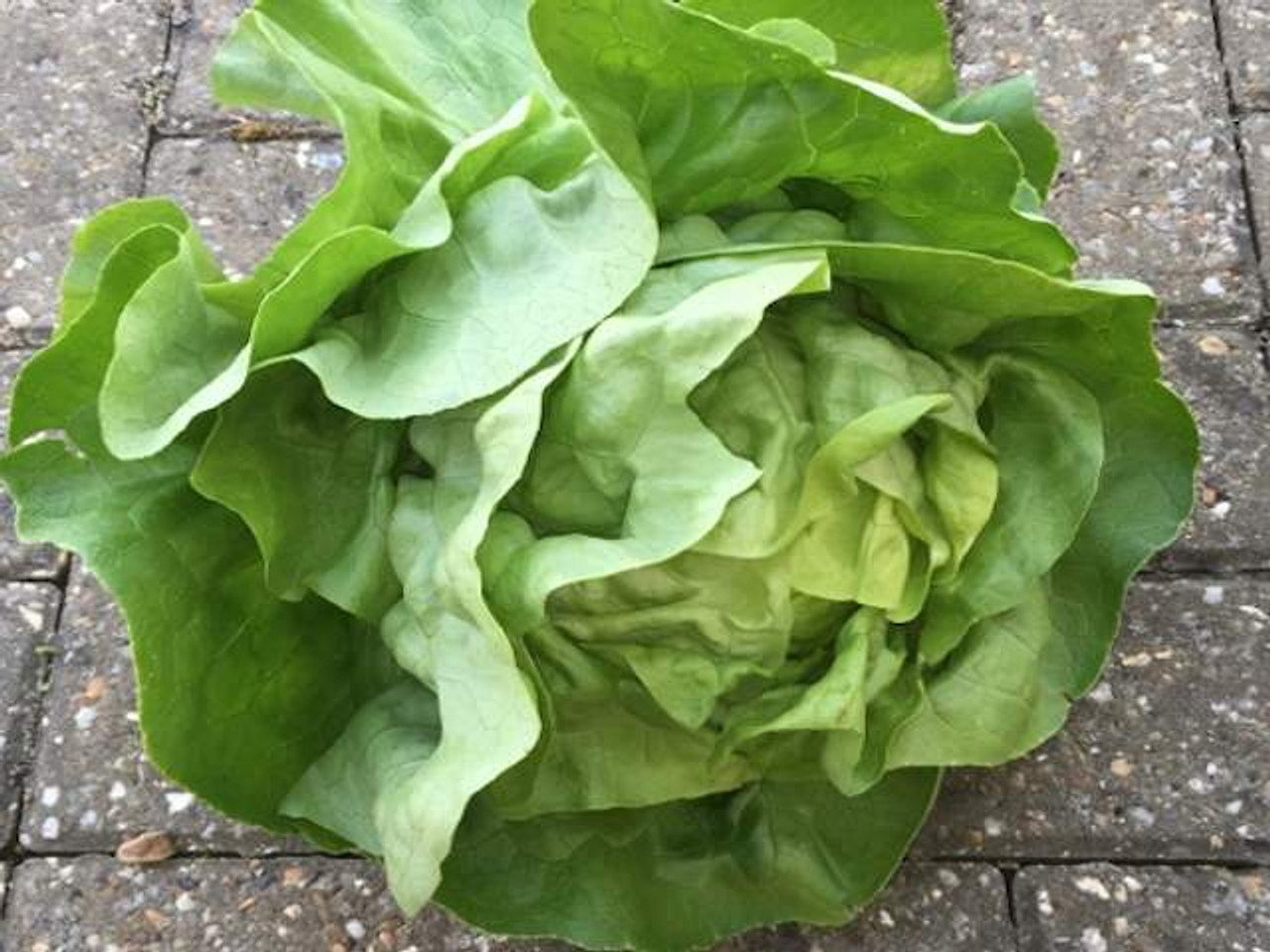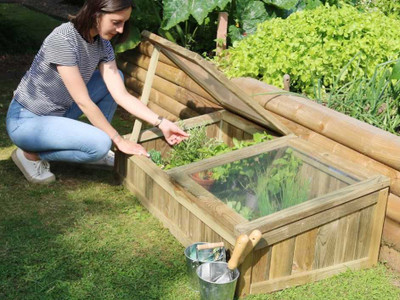How To Grow Lettuce

Lettuce is a favourite in the garden because it is relatively easy to grow, is one of the first crops that can be planted, and is one of the first crops to yield in the spring. It doesn’t take a lot of room, and because of its shallow root system it also does very well in containers.
When to grow lettuce:
You can plant lettuce 2-4 weeks before the last frost date, and in the fall about 6-8 weeks before the first frost date.
Lettuce is somewhat tolerant of frosts, although it will not take extended freezing temperatures. On the other hand, it will tend to bolt in higher temperatures. Because of this it is very productive in fall gardens and can provide homegrown salad leaves late in the year.
Also, it doesn’t pay to let it go: lettuce is better picked early than late.

Where to grow lettuce:
Lettuce will do well with 5 or more hours of sunlight a day.
Growing under cover such as cloches will make the most of weak sunlight and the plants' own heat, warming the crop and soil. A collapsible tunnel or growhouse is a handy alternative to a rigid cloche. A polytunnel is a very good environment for autumn growing but can run the risk of overheating during the warmer months.

Easy Poly Tunnel Cloche
View Product
Inter-cropping
Because lettuce crops prefer cool conditions, they are ideal for inter-cropping: i.e. growing them near other vegetables which crop at a different time (normally later). Plant lettuce where runner beans, broad beans, peas, brussels sprouts or sweet corn will provide them with shade during the hottest part of the day.
If you do grow lettuce near taller vegetables, take care that they are not deprived of water. Lettuce needs lots of water to mature quickly, and larger crops may take the lion's share of moisture. If this is the case, water the lettuce well in dry conditions.

Soil
A moist well drained fertile soil which has had plenty of compost dug in the previous autumn is best. In general lettuce is a light feeder.
A soil pH of about 6.0 to 7.5 is preferred. If you are planting in a container then try to get a soil depth of at least 6-8 inches.

Lettuce, Cos 'Little Gem'
View ProductSowing Lettuce
There are many different types and varieties of lettuce, but with regard to sowing we either want one single head of lettuce or a bunch of plants for cut and come again production. I always like to sow in modular trays, but I find it especially beneficial for lettuces as the emerging seedlings are so prone to slug attack.
Important: Many lettuce varieties fail to germinate when the temperature of the compost is above 25°C. This can often happen when raising seedlings in a greenhouse or polytunnel in spring and summer. To avoid this, place the seedlings in a cool shed for 2 days to germinate. Once they have germinated put them back in the tunnel; temperature is not an issue once the plants are up.

Sowing in Modular trays
Use a seed compost which has a finer texture and lower nutrients than your standard multipurpose compost. We use a seed module tray with each section being approx. 2 inches deep.
Here's what you do:
- Fill the seed tray with compost and brush off any excess.
- When filling the tray rub the compost through your hands to break up any lumps.
- Give the tray a sharp bang on your table to settle.
- Don't make holes! With your fingers make very small depressions in each cell. Lettuces need light to germinate so we will not be burying the seed, the depressions should be just enough to keep the seed in the middle of the cell.

Klasmann Organic Seed Compost - 70 Litre
View Product
Single head or cut and come again?
If you want a single head of lettuce, sow 1 seed per module. If you are growing a 'mat' of lettuce for cut and come again, sow 3-5 seeds. Make sure you have the right variety for each.
Don't cover seeds
I know you'll want to, but don't cover the lettuce seed or you'll get a very poor germination rate. You will need to keep the compost moist at all times; just don't cover them.
Gently water your seeds. A good tip is to use a plastic bottle with small holes punched in the cap. This is less likely to wash the seed around than the heavy spray from a watering can.

Bottle Top Waterer 4 Pack
View ProductPlace your trays in your greenhouse, polytunnel, cold frame or windowsill to germinate. They should be ready to plant out in about 4 weeks.
Hardening off lettuce seedlings
Seedlings started indoors in trays or modules can be planted outside after danger of severe frost has passed.
It is crucial to harden off lettuce raised indoors before planting out. Plants that have been raised indoors will need to get used to the outdoor temperature and conditions before they can be planted outside. This will take about a week to 10 days depending on the weather.

Vegtrug Cold Frame 1m
View ProductThe best way to achieve this is to use a cloche, cold frame or mini-greenhouse. You can leave the cloche off the plants on dry, frost-free days and replace at night. Gradually increase the time with the cloche removed until the end of the week, when you leave it off both day and night. Alternatively you can use a cold frame and prop the lid open during the day etc.
If the weather is mild you may not need cover: just move the plants outside for longer periods each day. If you have started your seeds on a windowsill, you will need to leave them in an unheated room for a day or two before moving outside to the cloche. It's best to harden off and plant out under fleece.
Transplanting:
Make a hole with a dibber or suitable stick approx. 9 inches apart (a piece of an old broom handle is ideal). Place the seedling plug in the hole and firm gently around the roots; water well.

Planting Out
Spacing
The spacing for lettuce varies depending on what you're planting:
- Small Lettuce (Little Gem): 20cm between plants and 20cm between rows.
- Medium Lettuce (Lollo types, butterheads): 25cm between plants and 25cm between rows.
- Large Lettuce (Iceberg): 35cm between plants and 35cm between rows.
- Cut and come again: 25cm between plants and 25cm between rows.

Lettuce 'Lollo Rossa'
View Product
Planting
It is important to plant lettuce with its seed leaves above the ground. The seed leaves are the 2 lowest leaves on the stem. If these leaves are buried the stem is likely to rot and you'll lose your lettuce plant.
If your lettuce seedlings have gone a bit leggy (have a long stem), you can plant a bit deeper to cover the stem - but never further than the seed leaves.
Lettuce Crop Care
The key requirements are water and weeding. Both can be greatly assisted by laying a covering of organic material (or black plastic cut to allow the seedlings through) around the plants: this will keep the soil moist and stop the growth of weeds. It can also provide a slow but steady stream of nutrients.

Pests and diseases
Lettuce has a few enemies which may not kill the crop, but will slow down growth and make the plants less healthy.
They include lettuce root aphid (yellowing and decaying roots), lettuce root maggot (maggots present on the roots), greenfly and slugs. A few basic precautions can prevent problems developing:
- Weed the bed: weeds provide a home for pests and diseases.
- Remove harvested lettuce from the ground completely: do not leave the stump in the ground. It will rot and attract the attention of pests, root aphid in particular
- Provide them with sufficient water, especially in dry periods.
- Do not grow lettuce in the same beds as has been previously used for chrysanthemums. Doing so will increase the risk of root maggot.

Harvesting Lettuce:
Harvesting your lettuce at the correct time is important for maximizing its flavor and texture. If you let your lettuce crop sit in the garden too long, it will increase in bitterness and the leaves will become tougher. Lettuce is generally ready to harvest about 80 days after planting with seeds and about 60 days after using seedlings.
Lettuce of one sowing will usually be all ready at the same time.
If you grow romaine or butter leaf lettuce, you should first remove the outer leaves, then dig up the entire plant and cut it off at the base. This way, it’s possible to have a second crop. For crisphead lettuce, let the center reach full firmness before you harvest.

Lettuce Butterhead All Year Round
View ProductLoose leaf types and cut and come again mixes can be harvested a number of times. Remove the outside leaves of the plants and the centre will continue to produce new leaves for 2 or 3 cuts.
Top Tip: The earlier in the day you harvest your lettuce, the longer it will keep and the more nutritious it is. If you set your alarm clock for 6am and cut your lettuce it will keep in a plastic bag in the fridge for a week. Harvest at 2pm on a sunny day and it will be wilting (plants take in moisture at night and let it out during the day).
Storage:
Separate leaves and wash under cold water. A salad spinner is a worthwhile investment as dry leaves will keep in the fridge much longer. When lettuce is washed and properly stored, it stays fresh in the fridge for about 5 to 6 days. However, note that lettuce that you've washed yourself and stored properly will last longer then pre-washed lettuce.



